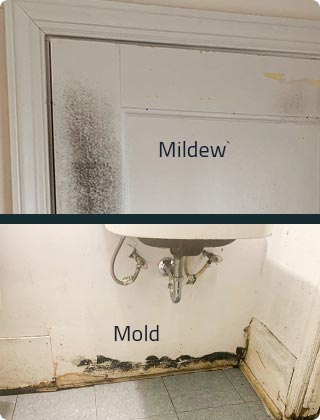
Mold vs. Mildew: What's the Difference?
Not sure whether you're dealing with mold or mildew? You're not alone. These two fungi often get lumped together - and at a glance, they can look frustratingly similar. But while they share some traits, there are important differences in how they grow, the damage they cause, and how you should handle them.
Understanding the difference between mold and mildew isn't just a matter of curiosity - it can impact your health, your home, and your next step. Mildew is typically a surface-level issue and often harmless if caught early. Mold, on the other hand, can run deeper, spread faster, and in some cases, pose serious health risks.
In this guide, our mold inspection team break down exactly how mold and mildew differ - by color, texture, smell, location, and health impact - and help you decide when a basic clean-up might do the trick, and when it's time to call in a professional.
What Is Mold?
Mold is a type of fungus that grows deeper into surfaces and can cause health risks.
It typically appears in black, green, or blue shades and has a fuzzy or slimy texture. Unlike mildew, which stays on the surface, mold roots into the materials it grows on - making it harder to remove and more likely to cause long-term damage.
What Is Mildew?
Mildew is a surface-level fungus that is less harmful than mold but still problematic.
It typically appears as flat patches in white, gray, or yellow tones and has a dry, powdery or fluffy texture. Unlike mold, mildew stays on the surface of non-porous materials and doesn't root deeply.
Mold vs. Mildew: How to Tell Them Apart
While mold and mildew are both fungi that thrive in damp environments, they behave and spread in noticeably different ways. From the way they look to the threat they pose, here's how to spot the difference.
Appearance and Color Over Time
Mildew starts off as light-colored spots - typically white, gray, or yellow - and can darken to brown or black if left untreated. Mold usually shows up in darker, bolder colors from the beginning, like black, green, or blue, and tends to spread in irregular blotches or clusters.
Growth Patterns and Textures
Mildew stays flat and powdery, growing on the surface of the material. It's often described as soft, dusty, or even fluffy. Mold, in contrast, is thicker and fuzzier, with a damp, sometimes slimy texture. Mold can spread upward or inward, depending on what it's growing on.
Where They Grow
Mildew prefers hard, non-porous surfaces like shower tiles, glass, painted walls, or fabrics in humid rooms. Mold grows on porous or organic materials - drywall, wood, insulation, carpeting - and often hides in darker, concealed areas like behind walls or under flooring.
Odor Comparison
Mildew has a musty but relatively mild smell, often compared to damp towels. Mold has a stronger, earthier odor that tends to linger, especially in rooms with poor ventilation or ongoing moisture problems.
Severity and Cleanability
Mildew is usually easy to clean with a household cleaner or vinegar and a bit of scrubbing. Mold is more serious - it often returns after cleaning, especially if the source of moisture isn't addressed. Mold can cause structural damage and may require professional removal, particularly if it covers a large area or grows beneath the surface.
Health Risks From Mold and Mildew
Fungal growth indoors isn't just a cosmetic problem - both mold and mildew can have an impact on your health. However, the severity of that impact varies significantly depending on the type of growth and the duration of exposure.
Health Effects From Mold
Mold can cause significant health problems, especially with long-term exposure.
Its spores can irritate the nose, throat, and lungs, triggering coughing, sinus pressure, eye irritation, or fatigue. People with asthma, allergies, or weakened immune systems are more likely to experience strong or persistent reactions. Some molds produce toxins that may lead to chronic respiratory issues if not addressed early.
Health Effects From Mildew
Mildew may cause mild irritation but is rarely serious.
It can trigger minor symptoms like coughing, slight throat discomfort, or eye irritation, especially in people with allergies. However, since mildew stays on the surface and releases fewer spores, it typically doesn't affect indoor air quality the way mold does.
Mold vs. Mildew: Which Is More Concerning?
While mildew may cause temporary irritation, mold presents a more serious and lasting threat to both health and indoor air quality. Its ability to grow undetected, penetrate materials, and release large volumes of airborne spores makes it much more difficult to manage - and much riskier to ignore.
In short, mildew may be unpleasant, but mold can be dangerous.
That's why identifying which one you're dealing with is more than just a maintenance concern - it's a health decision. If symptoms persist or if you're unsure about what's growing in your home, it's best to get a professional evaluation.
O2 Mold Testing offers certified mold testing backed by lab analysis, helping you distinguish between surface mildew and deeper mold problems - so you can take action confidently and safely.
How to Prevent Mold and Mildew
Preventing mold and mildew comes down to one core principle: control moisture before it becomes a problem. Both fungi rely on damp, stagnant conditions to grow - and eliminating those conditions is the most effective way to keep them out of your home.
Control Humidity
Keep indoor humidity levels below 50%, especially in areas like bathrooms, kitchens, basements, and laundry rooms. Use a dehumidifier if necessary, and install a hygrometer to monitor levels consistently. Mold spores thrive in humid environments, so keeping the air dry is one of the simplest and most effective preventive steps.
Fix Leaks Immediately
Any leak - even a small drip under a sink or around a window - can introduce enough moisture to support mold or mildew growth. Repair roof leaks, plumbing issues, and damaged caulking promptly to prevent water from seeping into walls, floors, or insulation.
Keep Surfaces Dry and Clean
Regularly wipe down damp surfaces like shower walls, countertops, and windowsills. Avoid leaving wet towels, clothes, or cleaning rags in piles. Mildew often starts on surfaces that remain damp after use, while mold can take hold if moisture soaks into porous materials.
Ensure Proper Airflow
Good ventilation helps dry out wet areas and reduces stagnant air where moisture can collect. Use exhaust fans in bathrooms and kitchens, open windows when weather allows, and keep furniture slightly away from walls to allow air circulation. For enclosed areas like closets or cabinets, consider moisture-absorbing products or passive venting.
Build a Simple Prevention Routine
Staying ahead of mold and mildew doesn't require deep cleaning every day - just consistent habits.
- Daily: Run exhaust fans, wipe down showers and sinks, hang wet items to dry.
- Weekly: Clean high-moisture areas, check under sinks for leaks, empty drip trays under appliances.
- Monthly: Inspect window seals, test humidity levels, clean HVAC filters or vents.
Preventive steps like these not only reduce the risk of fungal growth but also improve overall indoor air quality. If you've been staying on top of prevention but still notice persistent odors or recurring spots, it could be a sign of hidden mold - and worth getting professionally inspected.
Mold and Mildew FAQs
Is mildew just a type of mold?
Yes, mildew is a specific type of mold. It grows on the surface of damp materials and is typically lighter in color and easier to clean than deeper, more invasive mold types.
Can mildew turn into mold?
Mildew is considered an early stage of mold, though it is not as aggressive or invasive. It thrives in moist environments and often appears as a white or gray powdery layer. While mildew doesn't transform into more serious mold, its presence can signal conditions that allow more harmful mold types to develop.
What smells stronger: mold or mildew?
Mold smells stronger than mildew. Mold has a musty, earthy odor that tends to linger and intensify over time. Mildew has a lighter, sour smell that's less persistent.
Can vinegar kill mold?
Vinegar can kill some types of mold on non-porous surfaces, but it is not effective for mold that has penetrated porous materials like drywall or wood. For deeper mold problems, professional treatment is recommended.
What's worse for health: mold or mildew?
Mold is worse for health than mildew. Mold can cause respiratory issues, allergic reactions, and long-term health problems with prolonged exposure. Mildew typically causes only mild irritation.
When to Call a Professional
Not all mold and mildew problems require outside help - but some situations call for expert attention. Knowing when to bring in a professional can save you time, money, and potential health risks down the line.
If you're unsure how serious the mold is - or whether you're even dealing with mold at all - it's time to bring in the experts. O2 Mold Testing provides certified mold testing backed by lab analysis, giving you clear answers and practical next steps.
Whether it's behind the walls or just starting to show, we'll help you get clarity fast - and keep your home safe.


